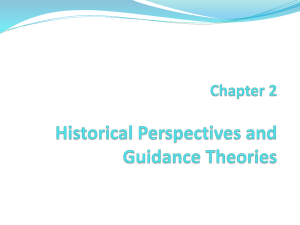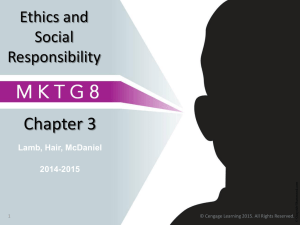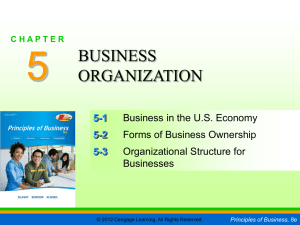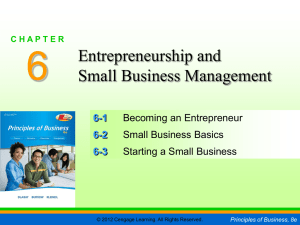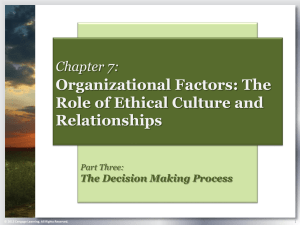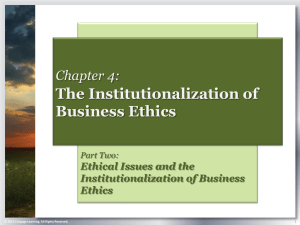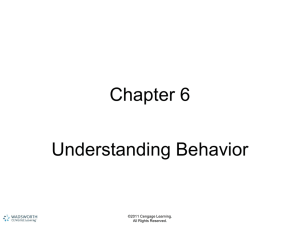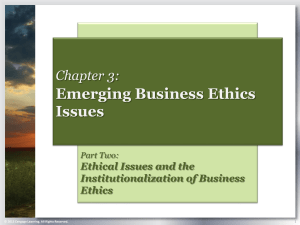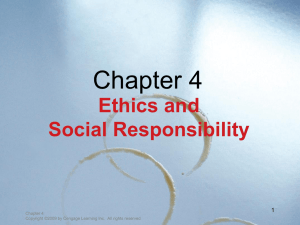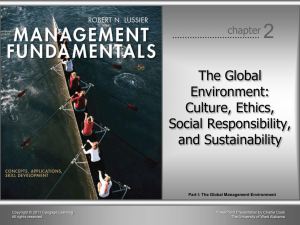Slide 1 - bus225wtcstudents
advertisement
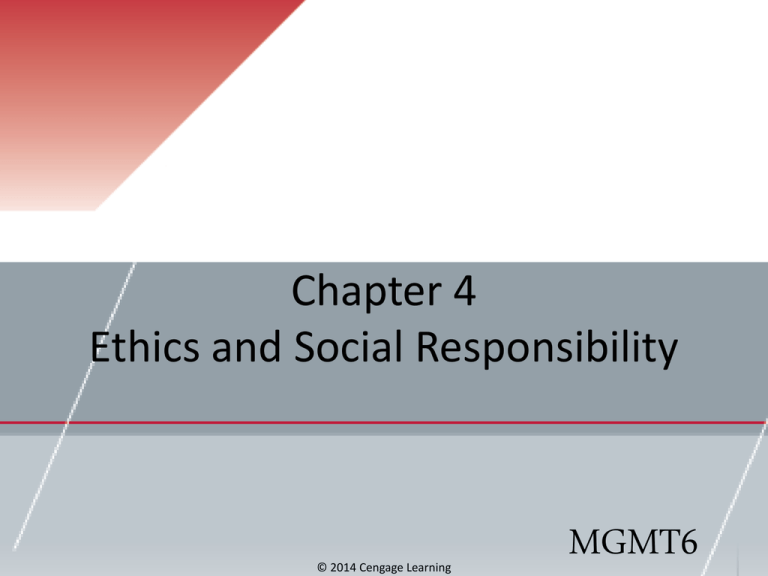
Chapter 4 Ethics and Social Responsibility © 2014 Cengage Learning MGMT6 4-1 identify common kinds of workplace deviance 4-2 describe the U.S. Sentencing Commission Guidelines for Organizations and explain how they both encourage ethical behavior and punish unethical behavior by businesses 4-3 describe what influences ethical decision making 4-4 explain what practical steps managers can take to improve ethical decision making 4-5 explain to whom organizations are socially responsible 4-6 explain for what organizations are socially responsible 4-7 explain how organizations can choose to respond to societal demands for social responsibility 4-8 explain whether social responsibility hurts or helps an organization’s economic performance © 2014 Cengage Learning Workplace Deviance • Ethical behavior – conforms to a society’s accepted principles of right and wrong. • Workplace deviance – unethical behavior that violates organizational norms about right and wrong. © 2014 Cengage Learning 4-1 © 2014 Cengage Learning 4-1 Who, What, and Why • Who – nearly all companies: nonprofits, partnerships, labor unions, unincorporated organizations, incorporated organizations, pension funds, trusts, joint stock companies • What – offenses defined by federal laws: invasion of privacy, price fixing, fraud, theft, embezzlement, etc. • Why – The purpose of the guidelines is not just to punish companies after violations, but to encourage companies to prevent violations before they happen. 4-2 © 2014 Cengage Learning © 2014 Cengage Learning 4-2 © 2014 Cengage Learning 4-2 Influences on Ethical Decision Making • Ethical intensity • Moral development • Ethical principles © 2014 Cengage Learning 4-3 Ethical Intensity The degree of concern people have about an ethical issue. •Magnitude of consequences •Social consensus •Probability of effect •Temporal immediacy •Proximity of effect •Concentration of effect © 2014 Cengage Learning 4-3 © 2014 Cengage Learning 4-3 Principles of Ethical Decision Making • • • • • • • Principle of long-term self interest Principle of personal virtue Principle of religious injunctions Principle of government requirements Principle of utilitarian benefits Principle of individual rights Principle of distributive justice © 2014 Cengage Learning 4-3 Selecting and Hiring Ethical Employees • Overt integrity tests • Personality-based integrity tests © 2014 Cengage Learning 4-4 Codes of Ethics • A company must communicate its code inside and outside the company. • Management must develop practical ethical standards and procedures specific to the company’s line of business. © 2014 Cengage Learning 4-4 Objectives of Ethics Training • Develop employees’ awareness of ethics • Achieve credibility with employees • Teach employees a practical model of ethical decision making © 2014 Cengage Learning 4-4 © 2014 Cengage Learning 4-4 Ethical Climate • Organizational culture is key to fostering ethical decision making. • Management needs to be active in and committed to the ethics program. • Encourage managers and employees to report ethical violations (whistleblowing) 4-4 © 2014 Cengage Learning To Whom Are Organizations Socially Responsible? • Shareholder model – the only social responsibility that businesses have is to maximize profits • Stakeholder model – management’s most important responsibility is not just maximizing profits, but the firm’s long term-survival. © 2014 Cengage Learning 4-5 Stakeholder Model of Corporate Social Responsibility People or groups who are interested in and affected by the organization’s actions. •Primary stakeholders •Secondary stakeholders © 2014 Cengage Learning 4-5 © 2014 Cengage Learning 4-5 For What Are Organizations Socially Responsible? • Economic responsibility • Legal responsibility • Ethical responsibility • Discretionary responsibility © 2014 Cengage Learning 4-6 Responses to Demands for Social Responsibility Social responsiveness: a company’s strategy for responding to stakeholders’ expectations concerning economic, legal, ethical, or discretionary responsibility. © 2014 Cengage Learning 4-7 Social Responsiveness Strategies • • • • Reactive Defensive Accommodative Proactive © 2014 Cengage Learning 4-7 Social Responsibility and Economic Performance • There is no tradeoff between being socially responsible and economic performance. • It usually does pay to be socially responsible. • There is no guarantee that socially responsible companies will be profitable. © 2014 Cengage Learning 4-8 Theo Chocolate <click screenshot for video> 1. Which of the four strategies for responding to social responsibility best reflects Theo Chocolate? 2. How does Theo Chocolate’s business practices reflect the stakeholder model of social responsibility? 3. What would happen if fair trade goals conflicted with a company’s primary responsibility to be profitable? © 2014 Cengage Learning
